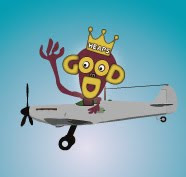... lets just say this is very much a work in progress..
(because at the moment it looks like somebody doing a poo or charming a snake)..
Bummer - the animated gif doesn't work on here, but here is the complete jpeg
- the thumb pops up and the sparks fly.
My off the cuff illustration is pretty dodgy but the working concept is someone giving the 'thumbs up' showing off their unique thumbprint that is being transmitted to the world - the slogan is 'your unique stamp on the world' which as a designer is the service that I offer!
Next step is to create a proper graphic of the hand and thumb - everything rests on this to make me look the business, but I'm happy with the concept... I think it's kind of cheeky and irreverent, which I like and it's where I'd want to position myself in the market.
What do you guys reckon?

